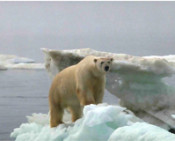
The first Russian Arctic reserve – “Wrangel Island” state nature reserve established
March 23, 1976 was signed a decree by the Council of Ministers of the RSFSR № 189 on the establishment of Wrangel Island State Reserve, including Wrangel Island and Herald, for the protection of unique natural complexes of the islands. "Wrangel Island" nature reserve is the most northern of the reserves of the Far East.
Wrangel Island and Herald together with the adjoining 12-mile sea area, located in the Eastern Region of Chukotka Autonomous Okrug, was a key territory for the lifecycle of a number of rare and specially protected animal species in the Arctic. This region is the most northern of all World Natural Heritage - it is about 500 km north of the Arctic Circle, at 71 degrees North latitude. The territory has a biodiversity which is exclusive for the Arctic. All sorts of arctic tundra dominate here, as well as relict tundra-steppe communities with a large variety of flowering plants.
Existence of a large island in this sector of the Arctic Ocean was predicted back in the 18th century by M. V. Lomonosov. In 1763, the scientist showed on the map of polar regions to the north of Chukotka a large island "Somnitelny" The first who told the world about the existence of the island, was lieutenant of the Russian fleet, F. P. Wrangel, who explored the land in 1820-ies. Herald Island was discovered in 1849 by British sailor G. Kellett and named in honor of his ship. In 1911, the Russian expedition on the ship Vaigach reached Wrangel Island and set up there a Russian flag, and 5 years later the island became part of the Russian Empire. In 1926, by decision of the Soviet government, here was established a permanent settlement, chief of which was the Russian Arctic explorer G. A. Ushakov. Later on the island was established a meteorological station and started regular scientific researches.
The first environment protection measures were introduced on Wrangel Island as early as 1930s. In 1953, the Chukotka government adopted a resolution on the protection of rookeries of walruses on the island, and in 1968 there was organized the reserve for the protection of walruses, polar bears, nesting white goose, black geese and colonial settlement of sea birds. In 1976, on these lands was created Russia's first Arctic reserve.
The objective for creation of a nature reserve was the preservation and study of typical and unique ecosystems of the Arctic island. In the reserve there is the world's largest concentration of ancestral polar bear dens, there also is the only one in Asia large breeding colony of white geese. In addition, the island is home to unique island population of musk ox and reindeer. On the spits of Wrangel Island form the largest coast rookeries of walruses north of the Bering Strait.
In 2004, the Reserve as an area where in the evolutionary process had developed a unique natural complex, was put on the list of World Natural Heritage of UNESCO.
The creation of an extensive protected marine area around the islands of Wrangel and Herald provided a high conservation status to the Arctic region, which has ecological importance of global scale. By the model of Wrangel Island Russia created a model of integrated territorial nature protection in the Arctic, where the island and sea ecosystems are preserved as a whole.
Lit.: Беликов С. Е., Куприянов А. Г. Поведение белого медведя на о. Врангеля // Белый медведь и его охрана в Советской Арктике. М., 1977; Вартанян С. Л. Остров Врангеля в конце четвертичного периода: геология и палеогеография / Государственный заповедник «Остров Врангеля». СПб., 2007; Геккер Р. Ф., Городков Б. Н. Крайний Северо-Восток Союза ССР. Т. 1 (остров Врангеля). М., 1952; Животный мир острова Врангеля: Сб. научных трудов / Государственный заповедник «Остров Врангеля». Владивосток, 1986; Кестер Б. В. Арктический заповедник «Остров Врангеля». Магадан, 1980; Минеев А. И. Остров Врангеля. М.-Л., 1946; Остров ветров и белых медведей: фотоальбом / Государственный природный заповедник «Остров Врангеля», объект Всемирного природного наследия ЮНЕСКО. СПб., 2008; Стишов М. С., Пpидатко В. И., Баpанюк В. В. Птицы острова Врангеля. Hовосибиpск, 1991.
Государственный природный заповедник «Остров Врангеля»: сайт. 2007-2012. URL: http://www.ostrovwrangelya.org/.
Based on the Presidential Library’s materials:
Development of the Arctic: [digital collection];
Врангель Ф. П. Очерк пути из Ситхи в С.-Петербург. СПб., 1836
Карта Сибири, Составленная по сведениям... . Б. м., 1844
Минеев А. И. Пять лет на острове Врангеля: о зимовках 1929-1934 гг. Л., 1936;
Экспедиция Академии наук СССР на остров Врангеля, 1938 г.: фрагменты кинохроники. СПб., 2010.

